Digital innovations like intraoral scanners have changed the face of dentistry and enhanced patient care quality. While obtaining an intraoral scanner may make intuitive sense, clinicians might consider carefully how it impacts best practices and how well they can incorporate it with other aspects of their practices.
This article briefly explains what intraoral scanners are and how they enhance patient care and clinical best practices. We also discuss the factors dental professionals should consider when choosing and incorporating an intraoral scanner into their practices.
Benefits of an Intraoral Scanner in Modern Dentistry
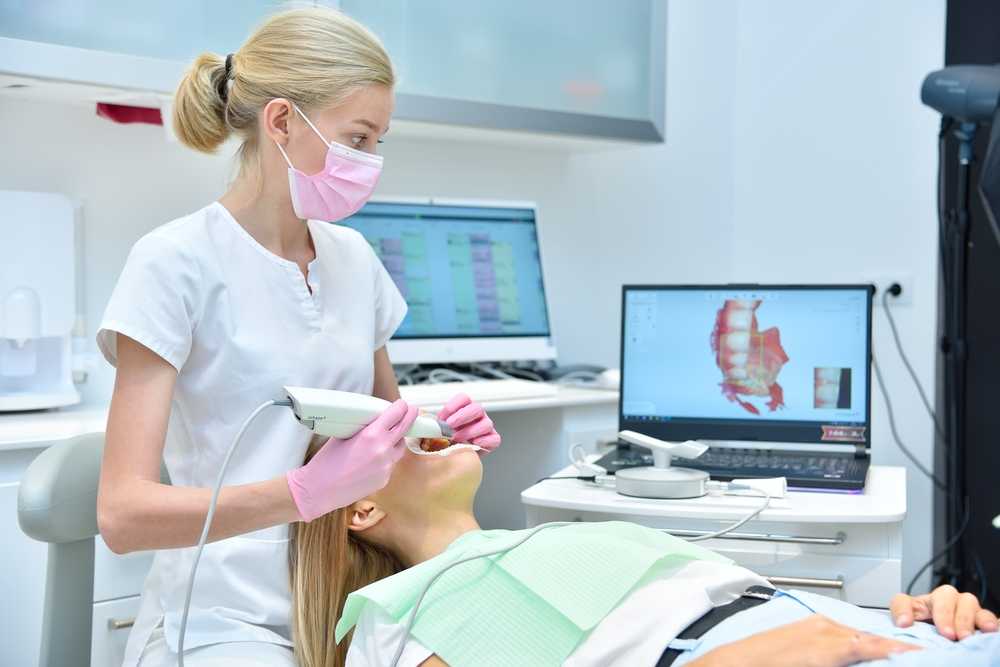
An intraoral scanner is a handheld tool dental professionals use to capture images of a tooth’s asperities or imperfections to create a three-dimensional (3D) model through software processing. This technique replaces more traditional vinyl polysiloxane impressions. For example, a scanner can produce a 3D impression of a tooth with a cavity that a provider or patient can see from multiple angles.
The intraoral scanner represents the most innovative development in dentistry in recent years. Digital dentistry, with the help of scanning technology, makes three-dimensional printing or reproductions of prostheses possible. It also helps users better understand the nature and causes of various severities, which can inform proper treatment. Other benefits of intraoral scanning include:
- More comfortable for patients with gag reflexes
- Better infection control and increased hygiene
- More precise digital impressions that are easier to transmit to colleagues and labs for smoother collaborations and better workflows
- The ability to transmit images digitally without the use of stone models, which take more time to create
- Reduced time commitment by patients
- Increased image accuracy
- Cost savings due to eliminating the need for impression material and shipping expenses
When in the market for an intraoral scanner, a clinician should consider how well a particular device will fit into their unique practice, given the services they offer and the types and numbers of patients they serve. Several factors should be examined when choosing a scanner.
Intraoral Scanner Accuracy
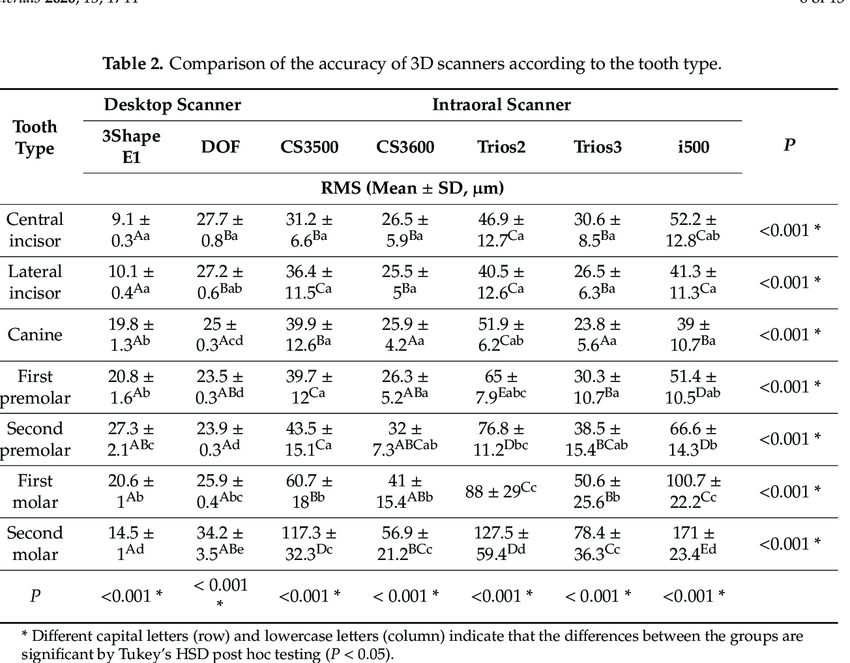
Despite their use of the latest technology, most intraoral scanners vary in their accuracy levels, more specifically, the accuracy of the digital impression a scanner yields. When inquiring about a product, a provider might ask for measures on two elements:
- Trueness is the capacity of a tool to capture the validity or value of the thing it attempts to measure.
- Precision refers to consistently producing the same image with repeatable results.
Scanners also produce images using different formats. Wavefront object (OBJ) and polygon (PLY) files typically generate higher-quality and accurate models, making a precise mesh. In contrast, stereolithography (STL) file formats create 3D models with approximate mesh structures of the object. These approximations can diminish trueness, which is essential to consider for images used to make prostheses. However, clinical practices that treat many patients needing minor bridges or single-unit crowns may achieve adequate results with STL files.
Calibration of Intraoral Scanners
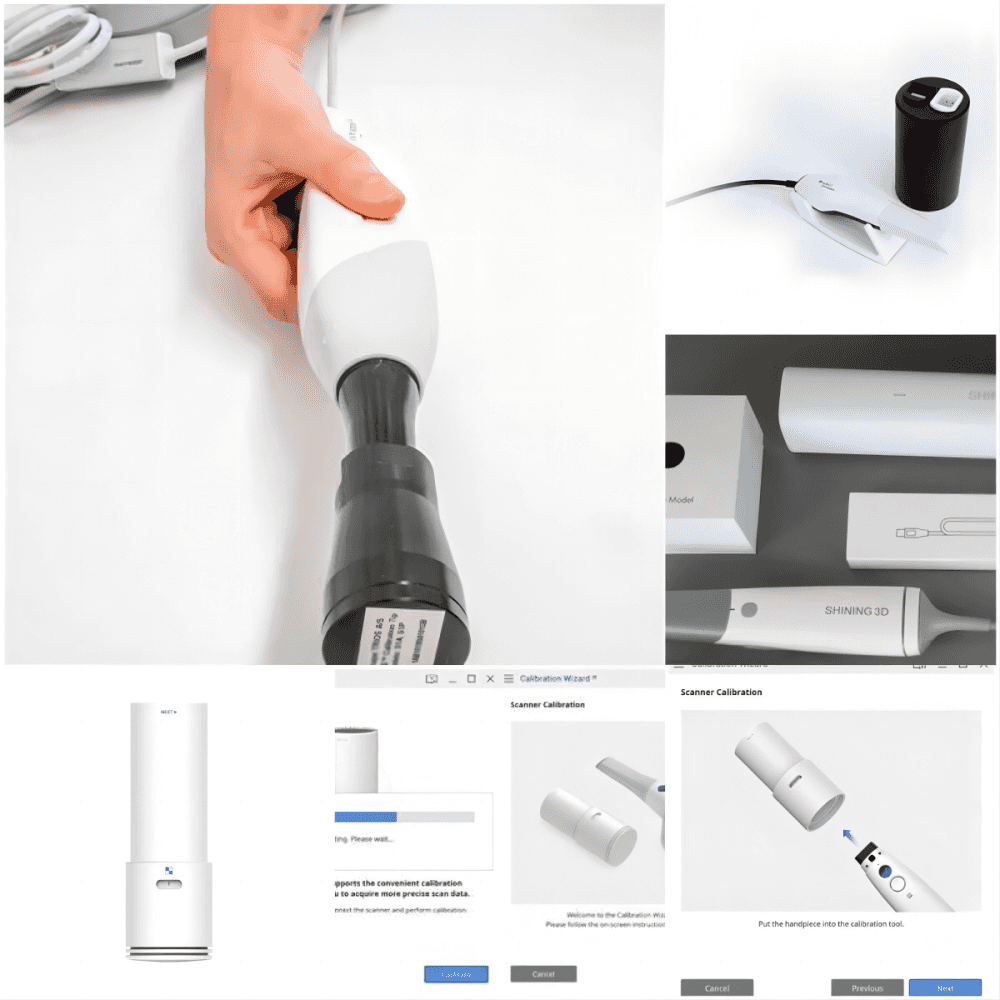
Intraoral scanners vary in how much calibration they need to be functional over multiple uses. If a dentist anticipates using the scanner relatively frequently or moving it from room to room, they may choose an instrument requiring minimal calibration or one with autocalibration.
Calibrating a 3D mouth scanner ensures accuracy by comparing measurements to a known reference object or points. The goal is to ensure that the scanner accurately measures the actual size of the object it is scanning.
You can do this by comparing the measurements to a known reference object or set of points. They call this process 3D calibration for an intraoral scanner. The objective is to synchronize the scanner’s data with the actual physical measurements of the object it is scanning.
Calibrating an intraoral scanner involves these steps:
- Prepare the scanner and a calibration object following the manufacturer’s instructions.
- Scan the object to create a 3D image using its shape, size, and pattern as a guide.
- Compare the scanned data with the known dimensions of the object to find any differences.
- Adjust the scanner’s settings based on the differences to improve accuracy.
Cost of Intraoral Scanners

A high-quality intraoral scanner is a significant investment, ranging from $19,000 to over $70,000. In addition to the initial scanner, some extra features and tools integrate with it and ongoing expenses. For example, most clinicians need a high-performing laptop that requires continual upgrades in addition to monthly or annual software subscriptions.
Also, most scanners are designed to accommodate supplemental features like orthodontic simulators. It’s always beneficial to consider the opportunity cost of such tools.
Factors Influencing Cost
- Brand and Model: Various brands provide different degrees of technology, speed, and integration abilities. Top brands like 3Shape, iTero, and CEREC are more expensive because they have better features and are more reliable.
- Features and Technology: Sophisticated features like high-resolution scanning, AI integration, color scanning abilities, and ergonomic design lead to increased costs. Scanners like iTero Element 5D, which can detect cavities using NIRI technology, usually cost more than basic models.
- Scanners compatible with CAD/CAM systems for fabricating dental crowns and treatment plans might be more expensive. These scanners enhance the process’s efficiency and fluidity.
- Software and Updates: Regular software updates and Support services are crucial for better scanner performance. These recurring costs can affect the total investment.
- Training and Support are crucial for dental staff to utilize the scanner effectively. Although they might be more expensive, they help maximize the scanner’s potential and efficiency.
Integrating Intraoral Scanners with Other Tools
An intraoral scanner’s capacity to integrate with other tools and systems in practice makes it more cost-efficient. In contrast, some scanners have a proprietary framework that prevents them from syncing with tools and software from other manufacturers or suppliers. Practitioners considering a particular intraoral scanner should check to see if it will interface with their current devices and frameworks, providing more flexibility and streamlined workflows.
Intraoral Scanner Design
Clinicians should pay attention to a scanner’s ergonomic design and its impact on the user and patient. Design features like tip size, the weight of the handheld scanner, and the ability to detach the tip can enhance or hinder the comfort of the scanning experience and affect the streamlining of the imaging process. Other design elements include wireless functioning, portability, and anti-fog capabilities.
Scanner Tip Sterilization
Health and hygiene should be a priority for all practices, regardless of patient volume. Providers should understand the sterilization methods that a scanner requires. For example, some scanners do not have detachable tips, requiring extra disinfection steps, such as cold sterilization or surface disinfectant wipes. Other scanners feature removable tips, allowing for more efficient sterilization and repeated use.
Scanner Speed
In an age of balancing speed of service and quality care, quickness in obtaining scans can save costs over time. Intraoral scanners vary in how quickly they capture a digital impression, and this difference is based on the following factors, all of which are necessary for a faster and smoother scan:
- The algorithm contributes to the speed of model stitching and fusion.
- Frame rate is the number of images a scanner’s built-in camera can take per second. However, taking more images increases the time necessary for point-cloud extraction.
- Image format is an aspect ratio issue or the number of extracted point clouds contributing to scan speed.
Software for Intraoral Scanners
Intraoral scanners come with software packages that help convert an initial scan to a 3D image. The ideal software system balances technological innovation and ease of use. The software interface should be intuitive, with the features on the portal being easy to navigate and manage. With the proper software design, clinicians can be more efficient in scanning and case management.
Customer Service and Support
No matter how well-designed or intuitive, an intraoral scanner should come from a manufacturer that backs up its product with excellent customer service, technical Support, and repairs. Practitioners might ask manufacturers about virtual or on-site training included in the price.
Software and hardware issues are always possible, and it is essential to know what Support a company offers, its customer service hours, and who is responsible for servicing the device and ancillary products.
Choosing the Right Intraoral Scanner
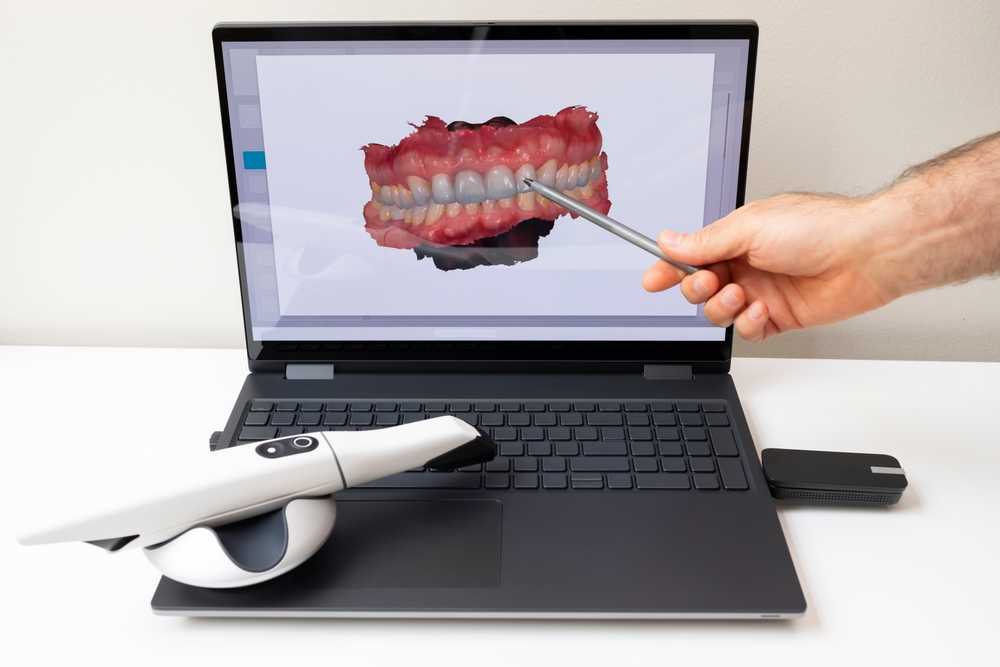
Selecting the proper intraoral scanner can improve patient care, promote dental best practices, and contribute to business sustainability. Even when the uses and benefits of an intraoral scanner are apparent, it can be daunting to select the proper tool without understanding factors like accuracy, cost, design, and integration, which should go into such an important decision.
At Universadent, we encourage each dental provider to take inventory of their clinical needs, patient load, and service offerings. This information informs the type of intraoral scanner that is best for their practice. We also answer questions and guide you in selecting a suitable scanner and other tools to advance patient care and help practitioners stay ahead of the dental technology curve.
Choosing the right intraoral scanner for your dental clinic is crucial to streamline operations and improve patient care. Here are some top intraoral scanners to consider:
1. Medit i700 ($12,900.00)
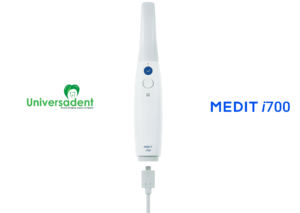
Known for its high accuracy and speed, the Medit i700 offers advanced features like AI-driven and color-scanning capabilities. It’s designed for seamless integration with CAD/CAM systems, enhancing workflow efficiency.
Pros:
- High Accuracy: Known for precise intraoral scanning, suitable for detailed restorative and orthodontic work.
- Speed: Fast scanning capabilities enhance workflow efficiency.
- AI Integration: Utilizes AI-driven scanning technology for enhanced automation and accuracy.
- Color Scanning: Offers color scanning capabilities that are beneficial for aesthetic treatments.
- Value for Price: Generally positioned competitively in terms of price compared to other high-end scanners.
Cons:
- Limited integration with some CAD/CAM systems compared to competitors like CEREC.
Why Dentists Should Consider:
- Ideal for practices needing high accuracy and speed with advanced scanning capabilities.
- Cost-effective option without compromising on quality.
2. 3Shape TRIOS 4 ($16,999.00)
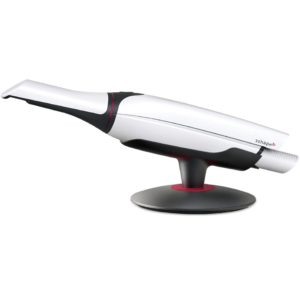
The 3Shape TRIOS 4 Intraoral Scanner stands out for its precision, speed, and advanced diagnostic capabilities, making it a valuable tool for modern dental practices. While the initial cost and need for ongoing maintenance and training might be considerations, improved accuracy, patient experience, and workflow efficiency make the TRIOS 4 a worthwhile investment for enhancing clinical outcomes and patient satisfaction.
Pros:
- Exceptional Speed: Rapid scanning capabilities reduce chairside time.
- Accuracy: High precision for both restorative and orthodontic procedures.
- Wireless Connectivity: Offers flexibility and convenience in clinical settings.
- Intuitive Software: User-friendly interface with advanced features for treatment planning.
Cons:
- Initial setup and training may require more time compared to simpler scanners.
- Higher initial investment cost.
Why Dentists Should Consider:
- Suitable for practices valuing speed, accuracy, and comprehensive treatment planning capabilities.
- Ideal for integrating into digital workflows with CAD/CAM systems.
3. Carestream CS 3700 ($6,999.00)
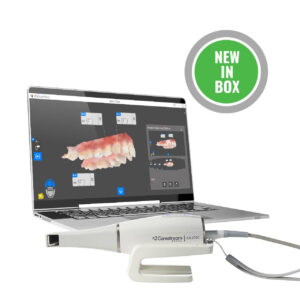
Carestream CS 3700 combines high-speed scanning with exceptional accuracy, making it suitable for various dental procedures. It also features smart-shade matching technology and an ergonomic design for patient comfort.
Pros:
- Smart-shade Matching: Advanced technology for precise color reproduction.
- Ergonomic Design: Patient-friendly and comfortable for extended scanning sessions.
- Versatility: Suitable for a wide range of dental procedures with high accuracy.
Cons:
- There may be a steeper learning curve for new users.
- Compatibility with some CAD/CAM systems may vary.
Why Dentists Should Consider:
- Great for practices focusing on precise color matching and ergonomic design.
- Offers versatile scanning capabilities for various dental applications.
4.Planmeca Emerald S ($12,999.00)
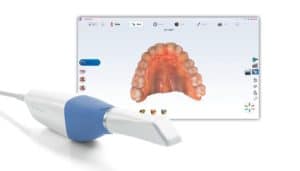
Known for its small tip size and lightweight design, the Planmeca Emerald S offers fast and precise scanning capabilities. It integrates seamlessly with Planmeca’s digital ecosystem for comprehensive treatment planning.
Pros:
- Compact Design: Lightweight and ergonomic for ease of use.
- Fast Scanning: Quick capture of detailed 3D images.
- Integration: Seamless integration with Planmeca’s digital ecosystem.
Cons:
- Limited availability in some regions compared to other brands.
- May require specific training for optimal use.
Why Dentists Should Consider:
- Suitable for practices seeking a compact, high-speed scanner with seamless integration capabilities.
- Offers efficiency in treatment planning and patient management.
5. iTero Element 5D ($12,900.00)
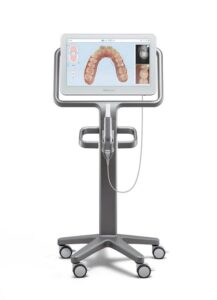
Discover the iTero Element 5D, a cutting-edge intraoral scanner to revolutionize your dental practice. The iTero Element 5D uses advanced imaging, like NIRI technology, to detect cavities between teeth without invasive procedures. It instantly gives a detailed look at a patient’s oral health.
iTero Element 5D offers enhanced precision and efficiency, ensuring accurate digital impressions for orthodontic, restorative, and implant dentistry. Elevate your practice with the iTero Element 5D and experience the future of dental technology today.
Pros:
- Integrated NIRI Technology: Enables caries detection alongside 3D scanning.
- Real-time Feedback: Provides immediate scanning feedback for adjustments.
- Invisalign Compatibility: Specifically designed for Invisalign treatment planning.
Cons:
- Higher initial cost due to advanced technology features.
- Requires regular updates and maintenance for optimal performance.
Why Dentists Should Consider:
- Ideal for practices specializing in orthodontics and requiring advanced scanning features.
- Offers unique benefits like caries detection and real-time scanning feedback.
6. CEREC Primescan Connect ($10,999.00)

CEREC Primescan Connect offers dental practices advanced connectivity, efficiency, and high-quality digital impressions, making it a valuable investment for enhancing clinical workflows and patient care outcomes.
Comparison Summary:
- Accuracy and Speed: All scanners excel in accuracy, with variations in scanning speed.
- Special Features: Each scanner offers unique features, such as AI integration (Medit i700), NIRI technology (iTero Element 5D), and smart-shade matching (Carestream CS 3700).
- Integration: Consider compatibility with existing CAD/CAM systems and digital workflows.
- Cost: Prices vary, with Medit i700 often noted for its competitive pricing among high-end scanners.
- User Experience: Factors such as ease of use, ergonomic design, and training requirements are crucial for seamless integration into practice workflows.
7. Medit i900 3D Intraoral Scanner ($14,500.00)
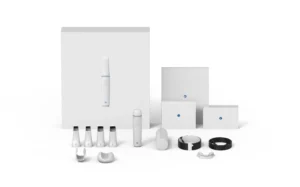
The Medit i900 3D Intraoral Scanner is a highly accurate and user-friendly tool that offers excellent value for its price. Its portability, fast scanning speed, and seamless software integration make it a strong choice for many dental practices. However, potential users should be aware of the initial setup, maintenance requirements, and the need for efficient data management.
Pros:
- High Precision and Accuracy: Delivers highly accurate 3D scans, ensuring reliable diagnostics and treatment planning.
- User-Friendly Interface: The intuitive design makes it easy for dentists and dental assistants to operate, reducing the learning curve.
- Cost-Effectiveness: It provides excellent value for its features, and it is often more affordable than other high-end scanners.
- Seamless Software Integration: It integrates smoothly with various CAD/CAM systems and dental software, enhancing its versatility.
- Portability: Its lightweight and portable design makes it convenient for use in multiple operatories or mobile dental services.
- Fast Scanning Speed: Capable of capturing detailed images quickly, reducing patient chair time, and improving overall efficiency.
- Comprehensive Support and Training: Offers robust customer support and training programs to help dental practices maximize the scanner’s potential.
Cons:
- Initial Setup and Calibration: To ensure optimal performance, initial setup and calibration may require time and effort.
- Learning Curve for Advanced Features: While the basic operations are user-friendly, some advanced features may require additional training and practice.
- Compatibility Issues: Although it integrates well with many systems, there may be occasional compatibility issues with specific software or hardware.
- Maintenance Requirements: Regular maintenance and calibration are necessary to keep the scanner functioning at peak performance, which can add to operational costs.
- Data Management: Handling and storing the scanner’s large data may require efficient data management solutions.
8. iTero Lumina Intraoral Scanner ($25,999.00)
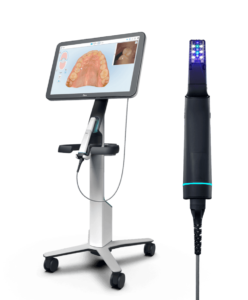
The iTero Lumina intraoral scanner is a game-changer for modern dental practices, offering unparalleled precision and efficiency. Known for its seamless integration with Invisalign, the iTero Lumina streamlines orthodontic workflows, enhancing both patient experience and treatment outcomes.
Its user-friendly interface and real-time feedback capabilities make it an excellent choice for dentists looking to improve diagnostic accuracy and communication. Despite its higher initial investment, the iTero Lumina’s comprehensive Support and advanced features ensure long-term value and improved clinical results.
Choose the iTero Lumina for cutting-edge digital impressions that elevate the standard of care in your dental practice.
Pros:
- Precision Imaging: Highly accurate digital impressions are crucial for precise dental restorations.
- Seamless Integration with Invisalign: Perfect for orthodontic practices, enhancing workflow efficiency and treatment outcomes.
- User-Friendly Interface: Easy-to-use software and hardware, reducing the learning curve for dental professionals.
- Real-Time Feedback: Provides immediate analysis and feedback, improving patient communication and satisfaction.
- Comprehensive Support: Backed by strong customer support and training resources from iTero.
Cons:
- Cost: Higher initial investment compared to some other intraoral scanners.
- Size: May be bulkier compared to newer, more compact models.
- Learning Curve for Advanced Features: While essential functions are user-friendly, advanced features might require additional training.
- Subscription Fees: Ongoing software updates and cloud storage costs can add up over time.
Comparison Summary:
When comparing the 3Shape TRIOS 5, Medit i900, and iTero Lumina, it is clear that each intraoral scanner caters to different needs within the dental industry.
- 3Shape TRIOS 5: Known for its advanced AI-powered scanning capabilities and intuitive interface, it is ideal for practices prioritizing cutting-edge technology and ease of use.
- Medit i900: This is a more budget-friendly option that does not compromise on essential features such as fast scanning and cloud integration, making it suitable for a wide range of dental applications.
- iTero Lumina: Excels in precision and is specifically beneficial for orthodontic practices due to its seamless integration with Invisalign. It provides immediate feedback and is supported by comprehensive customer service.
Conclusion
The best intraoral scanner for a dental practice depends on specific needs such as budget, workflow efficiency, treatment focus (restorative vs. orthodontic), and integration capabilities with existing systems. Dentists should evaluate these factors alongside the pros and cons outlined to make an informed decision that aligns with their practice goals and patient care standards.
When choosing an intraoral scanner, consider factors such as accuracy, speed, compatibility with existing systems, patient comfort, and Support and services offered by the manufacturer. Selecting a suitable scanner can significantly enhance clinical efficiency and patient satisfaction in your dental practice.

Comments are closed.